 |
|
At The Picture Show
|
May 2008
Different strokes
Two new horror films mine the same territory with contrasting results
Now here is a case study. Here are two movies cut out of the same mold. Different
filmmakers, different countries. Two drastically different approaches. Two
drastically different results.
This is the Home Invasion archetype. You may remember this subgenre came
under scrutiny a few months ago when Michael Haneke's Funny Games, a
deconstructivist rendition on the formula, was released. Surely both of these
movies - Bryan Bertino's The Strangers and Julien Maury and Alexandre
Bustillo's Inside - would be held squarely under Haneke's microscope.
But I am not Haneke, and I can love a good horror movie. What I see here as a
case study is the contrast between these two films - one a carefully measured
exercise in horror, the other an unrestrained self-parody.
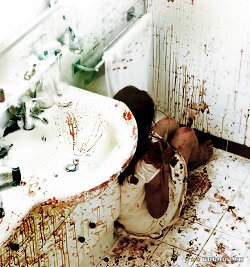 Both films are the debut works of their creators. One
is wiser than the other(s). As the Home Invasion formula goes, someone is
attacked at their home, seemingly without reason, and tortured unmercifully for
the better part of 90 minutes or so. At some point, we (or they, because we know
better) get teased with salvation when someone comes to the door . . . only to be
met with the harshest of physical retribution. The hero (or heroes) try to fight
back, they trick or wound their captors, etc, etc. Sometimes we get an explanation
as to why the person is being treated this way; sometimes the filmmaker veers
toward a more ambiguous or nihilistic tone. Some are relentlessly violent; others
keep it low-key until violence is absolutely necessary.
Both films are the debut works of their creators. One
is wiser than the other(s). As the Home Invasion formula goes, someone is
attacked at their home, seemingly without reason, and tortured unmercifully for
the better part of 90 minutes or so. At some point, we (or they, because we know
better) get teased with salvation when someone comes to the door . . . only to be
met with the harshest of physical retribution. The hero (or heroes) try to fight
back, they trick or wound their captors, etc, etc. Sometimes we get an explanation
as to why the person is being treated this way; sometimes the filmmaker veers
toward a more ambiguous or nihilistic tone. Some are relentlessly violent; others
keep it low-key until violence is absolutely necessary.
As you can tell, there usually aren't many options for this formula, but that doesn't
mean there aren't decisions to be made. The decisions made by The Strangers and
Inside, with the same basic set-up, are paramount, because one succeeds and one
dramatically fails. To paraphrase what Roger Ebert always says, a movie works
not because of what it is about, but how it is about it.
Both films use rather common victims to sucker us into sympathy. With The
Strangers, it's a young couple in a big, creaky house out in the middle of nowhere.
Inside goes with a pregnant woman . . . in a big, creaky house out in the middle of
nowhere. Where the films go their separate ways - and indeed, these two are as
dissimilar as they can be - is in the style of horror they choose to employ. There is
no right or wrong answer, of course - but these results speak for themselves.
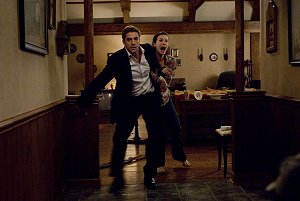 The Strangers - particularly the first half - is a
masterfully crafted exercise in suspense. With his careful framing of each shot, his
clever and haunting use of music, and his dogged insistence on emphasizing
setting and character before anything actually happens, Bertino sets us up with the
precision of a veteran filmmaker.
The Strangers - particularly the first half - is a
masterfully crafted exercise in suspense. With his careful framing of each shot, his
clever and haunting use of music, and his dogged insistence on emphasizing
setting and character before anything actually happens, Bertino sets us up with the
precision of a veteran filmmaker.
The characters, James (Scott Speedman) and Kristen (Liv Tyler) are already on
edge; he's just proposed to her and she has refused. We're anxious for them
already. And they're in the house, all alone, for the rest of the night.
Gradually, things start to feel a little bit . . . off. Bizarre knocks at the door. A cut
phone line. People standing outside in the distance, staring at the house.
Oh, and they're wearing masks, too.
The events themselves are altogether unspectacular, but the icy, uncomfortable
feeling the characters (and we) feel grows more palpable with every creaky step on
the wooden floor, every look out the window, every pregnant pause.
Instead of acting like morons who suddenly realize that they're the stars of a
horror movie, the characters proceed like normal, only gradually getting creeped
out enough to barricade themselves in the bedroom.
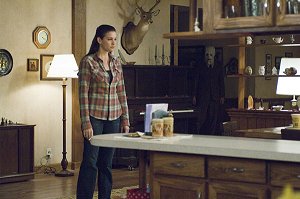 Bertino knows how to craft this kind of scenario
- that much is clear. His feel for shot composition is terribly impressive; with The
Strangers, he creates tension with pauses, silences and disquieting long shots
rather than rapidly edited close-ups. One character ominously peers out the
window to the darkness outside and . . . nothing happens. At least not yet.
Bertino knows how to craft this kind of scenario
- that much is clear. His feel for shot composition is terribly impressive; with The
Strangers, he creates tension with pauses, silences and disquieting long shots
rather than rapidly edited close-ups. One character ominously peers out the
window to the darkness outside and . . . nothing happens. At least not yet.
When something eventually happens at the window, the timing of it - and the
amount of time Bertino holds the shot - is executed to perfection.
There is one sequence that plays out in a few long takes, and is one of the best
scenes I've seen in a horror movie in some time. Kristen is alone in the house,
already tense after the strange events of the night. She walks around the living
room, walks toward the kitchen, lights a cigarette and stares ahead, caught in a
daze. In the far background of the shot, out from behind a wall comes the first
stranger, looking like the Scarecrow from Batman Begins, and he just stands there.
And stands there.
Nothing happens, and eventually he's gone. It has become the film's signature
shot - even appearing on the one-sheet poster - but just the shot itself, or the brief
clip of it from the trailer, doesn't do it justice. It's stunningly nerve-racking, and
what pay-off the film offers a little while later is due largely to this one scene.
As I began to suspect, the second half of the film doesn't live up to the promise of
the brilliant first half. Once things start escalating, they escalate to the point of no
longer mattering.
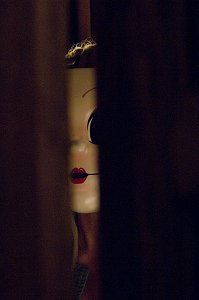 Still, The Strangers is an example of undeniably
well-crafted horror. The film is less violent than one would expect, the strangers
opting instead for psychological terror long before they raise a hand to anyone.
Still, The Strangers is an example of undeniably
well-crafted horror. The film is less violent than one would expect, the strangers
opting instead for psychological terror long before they raise a hand to anyone.
I was reminded most of last year's Ils (Them), a low-budget French horror film in
the same vein. It, too, utilized suggestive elements rather than blood, guts and
booming orchestral scores, and there's a even a distinct parallel with the shot
selection near the end of both films. In both cases, we idly see the perpetrators
from a distance, leaving . . . and in both cases, the suggestion of an eerie alienation
on the part of our intruders is done to hauntingly disturbing effect. It may be
nihilistic, but that doesn't mean it doesn't strike some sort of chord.
Now then. The complete opposite of that approach is utilized in Inside. That's not
to say that a bloodier, more blatant approach to horror is the wrong way to go. It's
just that, in this case, it undermines itself.
The pregnant woman is named Sarah (Alysson Paradis), and she lost her husband
in a car accident not long ago, leaving her alone and depressed on Christmas Eve,
the day before she is to give birth.
Someone comes to the door late at night - someone who seems to know too much
about her. Sarah tells her to go away, but the woman is resilient. She roams around
the house, looking in through the floor-to-ceiling windows. Sarah is immediately
disturbed, calling the police to check the area. No one is found.
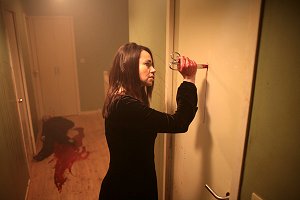 Eventually, the woman (played by the infamous
Béatrice Dalle) finds her way inside, and proceeds to . . . well, try to cut Sarah
open and steal her baby.
Eventually, the woman (played by the infamous
Béatrice Dalle) finds her way inside, and proceeds to . . . well, try to cut Sarah
open and steal her baby.
But that, of course, is only the start of the terror for Sarah. She somehow has the
strength to avoid that initial attack, and she somehow manages to lock herself in
an unusually well-secured bathroom. (I've never seen a bathroom with that many
locks on the inside. Oh, but I love the conventions of movies.)
The woman, billed only as "La femme" in the press materials, bides her time, but
she will not be deterred. When a friend comes by to see Sarah (he's supposed to
take her to the hospital in the morning), she tells him she's Sarah's mother. A
believable story.
But then, of course, the mother comes by. Both of these problems will have to be
disposed of.
And then there's the police. You knew they'd enter the picture at one point or
another. If for no other reason, just to remind us that policemen in movies are the
most incompetent of policemen. (At one point, when they've found Sarah in the
bathroom and know what they're up against, the policemen get the bright idea to
leave Sarah in the bathroom with a gun she doesn't know how to use, while
they go out into the pitch-black house and look for the killer, who's hiding
somewhere. Wow. Just . . . wow.)
Yes, as if you couldn't already figure it out from that anecdote, Inside is one of
those movies that uses the most implausible of character motivations and the most
obvious of plot holes to get from point A to point B. It's insulting, and no amount
of splashing blood and impressively creative murder techniques is going to change
that.
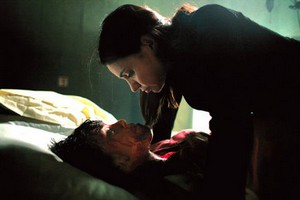 The self-serious tone the filmmakers employ here
eventually makes it nearly impossible to take the film seriously as horror. As
horror-comedy? Maybe . . . if it were actually trying to be a horror-comedy. But it
isn't. This movie thinks that it's chilling and atmospheric. It thinks it's a savage
take on the fears and desires of motherhood. What it is, in actuality, is cheap and
old-hat.
The self-serious tone the filmmakers employ here
eventually makes it nearly impossible to take the film seriously as horror. As
horror-comedy? Maybe . . . if it were actually trying to be a horror-comedy. But it
isn't. This movie thinks that it's chilling and atmospheric. It thinks it's a savage
take on the fears and desires of motherhood. What it is, in actuality, is cheap and
old-hat.
Both Inside and The Strangers are pretty much devoid of any significant meaning.
But only one of them actually realizes it. The Strangers isn't doing anything new,
but it does what it does extremely well. Inside isn't doing anything new, either.
But, like the Saw franchise, it overwhelms itself, overvalues itself and, when all
that is out of the way, is content to repeat itself.
Read more by Chris Bellamy